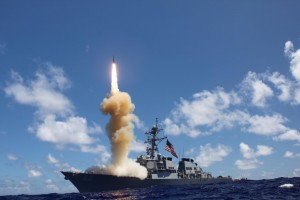 Photo credit: media.washtimes.com
Photo credit: media.washtimes.com
WW3
Pentagon Considers Deploying NUKES to Europe, Aimed at Russia
by Vladimir Kozin, Via Global Research:

WWIII ALERT: On June 4 a portion of a report by Army General Martin Dempsey, the chairman of the US Joint Chiefs of Staff, was declassified, in which he claims that Washington is considering deploying cruise missiles with nuclear warheads in Europe as a response to Russia’s alleged “violations” of the Intermediate-Range Nuclear Forces Treaty, or INF, which the United States and Soviet Union became party to back in 1987.
Four days later a similar statement was made by British Foreign Secretary Philip Hammond, whoannounced London’s willingness to once again accept US nuclear missiles, which were removed from British bases in 2006. In so doing, the United Kingdom has joined those who are criticizing Moscow for an “offense” that the Russians have never committed at any time or in any place.
The fact is that the new Russian R-500 operational and tactical cruise missile, which is mentioned in the American military documents, does not fall under any of the categories listed in the INF. That treaty required the destruction of two classes of nuclear missiles: ground-based ballistic and cruise missiles of “intermediate- and shorter-range,” meaning able to travel 1,000-5,500 km. and 500-1,000 km., respectively. The new Russian cruise missile in question has a maximum range of less than 500 km.
The Russians have not officially released any other information regarding its range. Nor have the Americans officially issued such information. In addition, the US delegation did not file any specific complaints about the missile during the special US-Russian consultations on arms control held last fall and this past spring. They just claimed that the Russians have tested “some kind of missile and they know what we are talking about…” But this is not a serious conversation. As Russia’s Foreign Minister Sergey Lavrov noted on June 9 of this year, “We are ready to examine any concrete evidence that gives the Americans reason to think that we have violated something.”
Russia’s next-generation intercontinental nuclear ballistic missile mentioned by the US (the RS-26 or Rubezh) has a range of over 5,500 kilometers and is also not subject to the INF’s restrictions, since that treaty does not apply to nuclear intercontinental ballistic missiles with a range of over 5,500 km. The numbers of those missiles are to be reduced principally through other agreements, such as strategic offensive reductions treaties.
Washington launched an extensive propaganda campaign a few years ago to discredit Russia in response to some type of INF “violations,” but has not yet provided any evidence of such “violations” by the Russians. That was the situation in January, July, and November of last year, when US officials made unfounded allegations in this regard against Moscow. And the same scenario is being played out again this year.

Martin Dempsey
The question arises: why does Washington need to create a manifestly counterproductive drama around some pseudo INF violations by the Russians, and particularly by resorting to a range of threats that have never before been issued in such a bombastic way?
The main reason is that the US is trying to prevent Russia from developing two effective missile “antidotes” to the American system to intercept ballistic and cruise missiles – Moscow is developing a new cruise missile and a next-generation intercontinental nuclear ballistic missile capable of challenging the high-tech US missile-defense infrastructure. Washington wants to be able to deliver a first nuclear strike against Russia, China, Iran, and other states without fear of reprisal, with an eye toward creating a future world order. After all, the Pentagon is retaining its offensive doctrines unchanged that allow for a first preemptive or preventative nuclear strike.
The second compelling reason why Washington has decided to trot out this improbable accusation about Russia’s INF “violations” is that the US itself has already repeatedly violated and continues to violate that treaty, when it uses “shorter-, medium-, and intermediate-range” ballistic and cruise missiles as targets to test its missile-defense systems. In particular, target missiles are being used such as the Hera (with a range of 1,100-1,200 km.), the MRT-1 (with a range of 1,100 km.), and the LRALT (with a range of 2,000 km.). Another example of Washington’s violation of this treaty will be if they install land-based cruise missiles in the launchers of the American missile-defense systems in Romania and Poland (that will become operational in 2015 and 2018, respectively), which can be equipped with a total of 48 missiles (24 missiles each).












